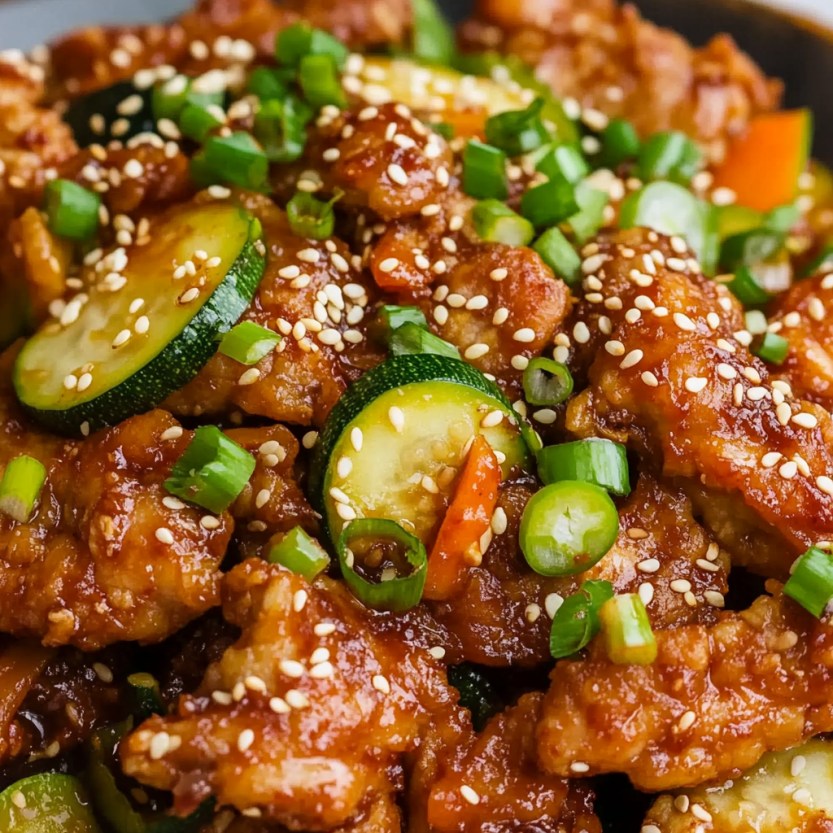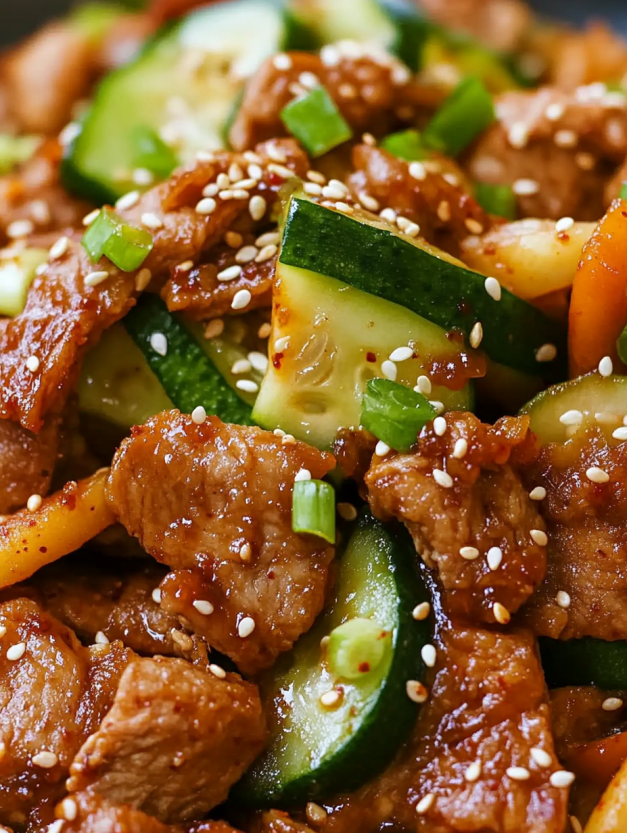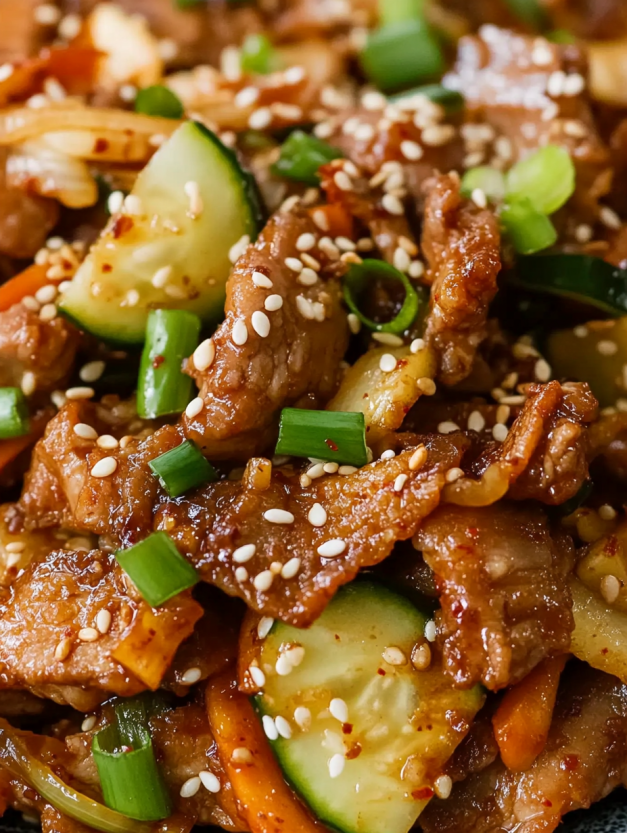 Save
Save
This Pork Bulgogi recipe is a flexible, family-friendly version of a classic Korean BBQ dish. You can make it spicy or keep it mild, depending on your audience. Packed with flavor and quick to prep, it's perfect for rice bowls, lettuce wraps, or meal prep.
The marinade is where the flavor lives: tender slices of pork soak up coconut aminos, gochugaru, garlic, ginger, and a bit of fruit for sweetness. Whether you spoon it over rice or stuff it in lettuce wraps, this dish delivers the kind of nostalgic comfort that reminds me of childhood dinners—except now I'm the one in the kitchen making it for my own family.
Ingredients You'll Need
- Pork tenderloin: Naturally tender and lean, this cut absorbs marinade well and cooks quickly. Pork shoulder or pork belly also work for different textures and fat levels.
- Coconut aminos: A gluten-free, soy-free alternative to soy sauce with a naturally sweet umami taste. You can substitute tamari (for gluten-free) or regular soy sauce (if you're not avoiding soy).
- Sesame oil: Adds that unmistakable nutty depth to the marinade.
- Korean red chili flakes (gochugaru): These flakes bring heat and smokiness. If you prefer less spice, reduce or skip it.
- Gochujang: A fermented red chili paste. Essential for a spicy Korean pork bulgogi with richness and heat.
- Garlic + ginger: Classic aromatics for depth and punch.
- Apple (or Asian pear): Sweetens and tenderizes the pork; a pantry-friendly substitute for traditional pear.
- Avocado oil: High smoke point and neutral taste, perfect for stir-frying. You could also use grapeseed or olive oil in a pinch.
- Onion, carrot, zucchini: Quick-cooking veggies that stay slightly crisp while soaking up the marinade.
- Green onion + sesame seeds: For garnish and that final Korean BBQ finish.
Tip: You can find gochugaru and gochujang at any Korean grocery store or online. Look for brands with clean labels if following paleo or Whole30 guidelines.
How to Make Pork Bulgogi
- Step 1:
- Slice the pork thinly and place in a resealable bag or glass container. In a blender, combine coconut aminos, sesame oil, gochugaru, garlic, ginger, and apple. Blend until smooth.
- Step 2:
- Pour marinade over pork. Cover and marinate at room temperature for 30 minutes or in the fridge for up to 24 hours. Drain pork, reserving the marinade.
- Step 3:
- Heat avocado oil in a large skillet over medium-high. Sear pork in a single layer (work in batches) for ~2 minutes per side. Set aside. In the same skillet, stir-fry onion, carrot, and zucchini until just tender.
- Step 4:
- Return pork to the skillet, add reserved marinade, and stir for 1 minute until bubbling and heated through. Serve warm, garnished with green onion and sesame seeds.
Pro Tip: For a more even cook and tender texture, partially freeze the pork before slicing. It makes thin slicing much easier.
 Save
Save
Tips for Spice Levels
Want a spicy pork bulgogi recipe? Add 1 tablespoon gochugaru and 2½ tablespoons gochujang to the marinade.
Need it milder? Skip the gochujang and cut the chili flakes in half (or out altogether)—it's still full of flavor.
Storage & Make Ahead
Store leftovers in an airtight container in the fridge for 3–4 days. Reheat in a skillet or microwave until warmed through.
Freezing Tips:
Cooked bulgogi can also be frozen in individual portions. Reheat gently to preserve texture.
Freeze raw pork in marinade in a sealed freezer bag for up to 2 months. Thaw in the fridge overnight, then cook as directed.
 Save
Save
Pork Bulgogi FAQs
What's the best cut of pork for bulgogi?
Pork tenderloin is ideal—lean, tender, and easy to slice thin. Pork shoulder works for a richer texture, while pork belly adds indulgent fat.
Can I make it without gochujang?
Yes! You'll miss a bit of fermented depth, but skipping it still yields a flavorful, family-friendly version.
Can I grill pork bulgogi instead?
Absolutely. Use a grill pan or outdoor grill and cook over medium-high heat, flipping after 2–3 minutes per side.
How long should I marinate the pork?
At least 30 minutes, ideally 4 hours or overnight. The longer it marinates, the deeper the flavor.
Recipe Questions
- → What's the best cut of pork for bulgogi?
Pork tenderloin is ideal for its lean, tender texture and ability to absorb marinades quickly. Pork shoulder offers richer flavor with more marbling, while pork belly adds indulgent fat content for those wanting extra richness.
- → Can I make this dish without gochujang?
Absolutely! While you'll miss some fermented depth, the dish remains flavorful and family-friendly. The marinade's other components like coconut aminos, garlic, ginger, and apple still create a delicious Korean-inspired flavor profile.
- → How long should I marinate the pork?
Minimum 30 minutes for decent flavor penetration, but 4 hours to overnight yields the best results. Longer marinating times allow the enzymes from the apple to tenderize the meat while flavors develop more complexity.
- → Can I grill this instead of using a skillet?
Yes! Use a grill pan or outdoor grill over medium-high heat. Cook for 2-3 minutes per side, watching carefully since the marinade's natural sugars can cause flare-ups. The smoky char adds authentic bulgogi flavor.
- → How do I adjust the spice level?
For spicy version, use 1 tablespoon gochugaru and 2½ tablespoons gochujang. For mild, skip gochujang entirely and reduce or eliminate chili flakes. The coconut aminos and aromatics provide plenty of flavor even without heat.
- → What vegetables work best with pork bulgogi?
Quick-cooking vegetables like onions, carrots, and zucchini maintain slight crispness while absorbing flavors. Bell peppers, snap peas, or mushrooms also work well. Keep cooking time short to preserve texture and color.